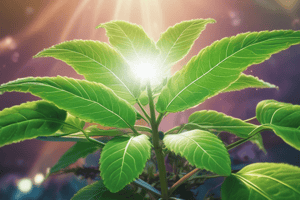Podcast
Questions and Answers
In photosystem II, what causes the thylakoid space to become strongly positive with respect to the stroma?
In photosystem II, what causes the thylakoid space to become strongly positive with respect to the stroma?
Hydrogen ions (H+) accumulating within the thylakoid space.
What provides the energy to make ATP in the thylakoid membrane?
What provides the energy to make ATP in the thylakoid membrane?
The difference in both charge and H+ ion concentration across the membrane (the gradient).
What protein complex allows H+ ions to pass through the thylakoid membrane?
What protein complex allows H+ ions to pass through the thylakoid membrane?
ATP synthase.
How are H+ ions able to pass through ATP synthase?
How are H+ ions able to pass through ATP synthase?
Signup and view all the answers
What does ATP synthase bind together to produce ATP?
What does ATP synthase bind together to produce ATP?
Signup and view all the answers
What is the role of hydrogen ions in the thylakoid space in photosystem II?
What is the role of hydrogen ions in the thylakoid space in photosystem II?
Signup and view all the answers
How does the ATP synthase protein complex generate ATP in the thylakoid membrane?
How does the ATP synthase protein complex generate ATP in the thylakoid membrane?
Signup and view all the answers
What is the source of the hydrogen ions that accumulate in the thylakoid space?
What is the source of the hydrogen ions that accumulate in the thylakoid space?
Signup and view all the answers




